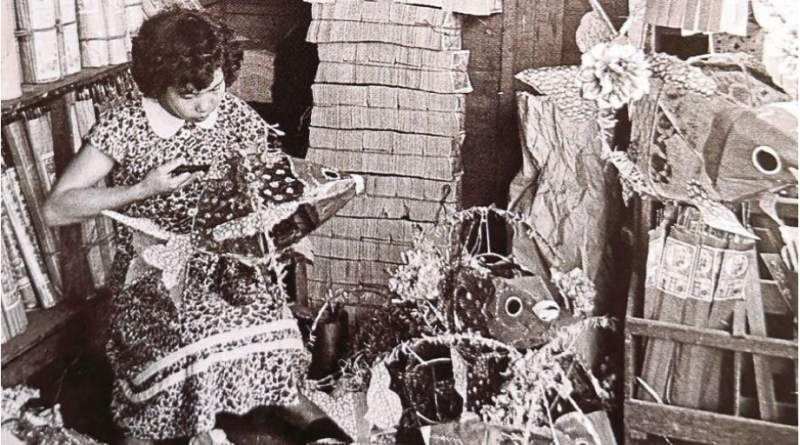Enchanting origin of Mooncake festival
“THOSE vintage mooncake boxes are very pretty. Prior to the 1960s, colourful cardboard containers such as these were a common sight in towns and villages In Malaya as people frequented famous bakeries and biscuit shops to buy the delicacy for their own consumption as well as to present them as gifts to relatives and friends,” my mother’s second sister said during a visit to drop off her fermented fish pekasam, which I enjoy with sambal belacan.
Keen to share her knowledge about life in the distant past, my aunt revealed that the Mooncake Festival falls on the 15th day of the eighth lunar month.
Referred by many as the Mid-autumn Festival as the date coincided exactly with the middle of autumn in China, this social observance, like many other traditions, was brought by Chinese immigrants who arrived by the tens of thousands in Malaya in the 19th century .
The festival was believed to have started more than two millennia ago as a form of post-autumn harvest celebration to thank the gods for a bountiful deliverance. Historians believe that the celebration owes its origin to the tradition of moon worship that began during the Song dynasty. Emperor Tai from the Northern Song dynasty was the first to designate the date as mid-autumn’s day.
“Like most Chinese festivals, folk tales connected with the Mid-autumn Festival began to appear soon after,” my aunt added, while gesturing at the picture of a woman on both boxes.
“That’s Chang-E, also known as the Moon Lady. The legend related to Chang-E and her husband, Hou Yi, is the most widely told and famous among all.”
She said that over the centuries, more than one version of the story had come into existence.
This myth, said to have originated from Tang dynasty storytellers, states that Earth once had 10 suns and the unbearable heat caused a drought that brought much misery to the people.
Hou Yi, a skilled archer and member of the Imperial Guard, rode his stallion to the peak of Mount Kunlun and shot down all but one of the suns with his bow and arrows.
As a reward for saving the world from destruction, Hou Yi was presented with the elixir of immortality, which, when consumed, would let him ascend to the heavens and become a celestial being.
Instead of jumping for joy, Hou Yi brought the potion home and gave it to his beautiful wife, Chang-E, for safe-keeping.
His undying love and unwillingness to leave her all alone in the world of mortals far outweighed the prospect of gaining an eternal place in heaven for himself.
One day, while Hou Yi was away hunting, his wicked apprentice, Feng Meng, went to his home to steal the elixir.
Chang-E tried her best to thwart his plans but was no match for his determination. Out of desperation, she found herself without any other viable alternative but to consume the potion herself.
Hoping to be as close as possible to her husband, Chang-E sought refuge in the moon, the place closest to earth, as she began to rise up to heaven.
Upon his return and after learning what had happened to his wife, Hou Yi sank into the deepest of sorrows.
Broken-hearted, he gazed upon the night sky and wondered where his beloved was at that moment.
Then, he noticed that the moon was extraordinarily large and bright. Looking closer, he saw the figure of a woman who bore close resemblance to Chang-E.
Brushing aside the distance that stood between them, Hou Yi laid out a table filled with Chang-E’s favourite delicacies and vowed to continue honouring his wife each year for the rest of his life.
This annual tradition became the basis for the Mid-Autumn Festival observance when people began praying to Chang-E as the Moon Goddess for safety and good luck.
Apart from making 13 types of offerings, signifying the number of months in a full lunar year, cosmetics were placed on the altar in the belief that it would be blessed by Chang-E and help beautify the user.
While drawing attention back to the depiction of Chang-E in a long traditional dress on the box covers, my aunt said that times had changed over the centuries and people today, especially the younger generation, had started to understand that the attainment of happiness and personal fulfilment no longer rested solely on favours from deities that they worship.
Despite this progressive outlook on life, other traditions related to the Mid-Autumn Festival have remained largely unchanged over the ages. The most enduring element of this celebration is the mooncake, which is so ancient that its origin is said to even predate the Mid-Autumn Festival itself.
The predecessor of the mooncake is believed to be the Taishi cake, which, according to historical records, first appeared in the Chinese provinces of Jiangsu and Zhejiang 3,000 years ago during the Shang and Zhou dynasties.
With its thin edge and a thick middle section, the snack was very different in nearly all aspects compared with the modern-day mooncake.
About a millennia later, Zhang Qian, who was sent on a diplomatic mission to the West as an imperial envoy, brought back sesame seeds and walnuts, which were then used as filling for a version of the Taishi cake, which people at that time called the Hu cake.
During the Tang dynasty, General Li Jing led a military assault to subjugate a group of nomadic people in medieval Inner Asia and returned triumphantly when the Mid-autumn Festival was in full swing.
Eager to make a contribution to commemorate the double celebration, a Tibetan trader presented the emperor with round cakes, which became popular with palace courtiers as well as the common folk.
Although people related the cake’s perfect circular shape and Li Jing’s resounding victory over their enemies, it was only decades later that the name we associate this festive delicacy with today was coined.
During a particular Mid-autumn Festival in the eighth century, Emperor Xuanzong was enjoying the cake in the palace garden with his beloved consort, Yang Guifei, whose beauty gained her fame as one of the most beautiful women in ancient China.
While comparing the cake to the full moon, Guifei suggested naming it “mooncake”. Her proposition must have gained wide appeal as the term started appearing in written historical records soon after.
“Most of us take the humble mooncake for granted each Mid-autumn Festival, but do you know that it played a special role in helping to bring a ruling power to its knees in the 14th century?” my aunt said.
By 1279, Mongol leader Kublai Khan had crushed the last Chinese resistance and established the Yuan dynasty. This was the first time in history that China was conquered and ruled by a foreign or non-native ruler.
The final years of the Yuan dynasty, however, were marked by struggle, famine and bitterness among the populace.
In less than a century, Kublai Khan’s successors had lost all influence over the Mongol people and the Chinese.
The reigns of the last few Yuan emperors were short and marked by intrigues and rivalries.
They were uninterested in administration and there was widespread unrest and dissension.
The Yuan armies were so weak and fragmented that they could not even stop petty outlaws from ravaging the country.
United in the single purpose of saving their country from destruction, several Han generals decided to secretly orchestrate a revolt to end the Yuan dynasty.
To get the message across to the population, the men took advantage of the approaching Mid-Autumn Festival by acquiring permission to distribute mooncakes as a symbolic gesture to honour the longevity of the Mongol emperor.
Specially-made mooncakes that had secret messages either in the form of embedded paper slips or incorporated in the surface design to form a puzzle were distributed to the people under the watchful eyes of Yuan soldiers.
The latter technique required people to cut the square-shaped mooncake into pieces and reassemble the different sections to reveal the hidden message. Then, the mooncakes were quickly consumed.
On the day of the uprising, unified resistance forces, under the command of Zhu Yuanzhang, overpowered the Yuan troops and drove the Mongols back to the Eurasian Steppe.
Zhu claimed the Mandate of Heaven and established the Ming dynasty in 1368.
“Since then, the practice of giving mooncakes as gifts became equally as important as enjoying them during the Mid-Autumn Festival.
“Although the practice of giving mooncakes to close friends and relatives has lasted until today, I must admit that the festival was celebrated with more unre-strained joy in the 1950s when the outlook on life was simpler,” said my aunt, who has lived in Alor Star all her life.
She recalled taking walks with her mother and siblings to buy mooncakes each time the Mid-Autumn Festival was around the corner.
“There was not much traffic in those days and we walked from our home in Pekan Cina to Yew Kee, the most famous bakery in town, in Lorong Najjah in Sungai Korok.
“Although the selection then was not as diverse as today, there were pastries on display to make our mouths water.”
The most popular mooncake type then came in the form of a dense pastry made of traditional red bean paste and lotus seed. Customers had the option of buying them plain or filled with single, double or even quadruple salted duck egg yolks.
Apart from providing colourful cardboard boxes that could contain up to four mooncakes each, shops like Yew Kee provided customers with specially-printed paper bag carriers as a nice addition to the festive atmosphere.
After all, the Mid-Autumn Festival is regarded as the second-most significant traditional Chinese celebration after the Lunar New Year.
At the same time, shops selling intricately-carved wooden mooncake moulds as well as those selling raw ingredients, like flour, nuts, sugar and eggs, also enjoyed roaring sales as some people preferred to make the delicacy at home.
Among the more popular activities planned during Mid-Autumn Festival in the past were evening gatherings of friends and family members in the garden to admire the full moon while nibbling mooncakes and sipping tea.
These joyous occasions were made even more exciting when the young take turns to solve riddles written on paper lanterns hanging from bushes and tree branches.
This form of intellectual entertainment was seen as a productive way to expand knowledge and inspire wisdom.
Clues were provided at the bottom of the lantern to help participants arrive at the correct answer.
Among the riddles my aunt remembers is the one about a small maiden wearing a pink jacket sitting in a boat without oars in the middle of the water.
She and her friends would be all smiles when someone came up with the lotus flower as the correct answer.
For my aunt and her family, Mid-Autumn Festival evenings in the past ended with moonlit walks in Alor Star and watching traditional opera performances.
Before taking her leave, my aunt acknowledged the fact that the way the festival is celebrated has changed over the years.
She found it interesting that people now make these ostentatious confections in almost every conceivable flavour, from durian and coffee to champagne and even truffles.
On top of that, the packaging techniques have become elaborate and luxurious.
Fortunately, despite the many changes, she is glad that the essence of the Mid-Autumn Festival has remained intact and hoped that it will continue to live on in this technology-driven and fast-paced world.
Source: NST



